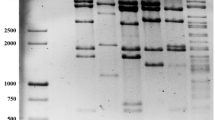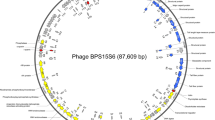Abstract
Escherichia coli is an important foodborne pathogen that can cause severe human disease. Here, we report the isolation and characterization of the lytic virus phi2013, which is specific for Escherichia coli laboratory strains. Transmission electron microscopy showed that phage phi2013 has an icosahedral head and a long, fragile, noncontractile tail, exhibiting the typical form of a siphovirus. Evidence revealed that the phi2013 genome is a linear double-stranded DNA molecule of 49,833 bp with 79 predicted genes without any known antibiotic resistance genes, virulence factor genes, or integrase genes. Moreover, the conserved outer membrane protein FhuA, which is present in members of several genera of the family Enterobacteriaceae, was identified as the receptor of phage phi2013. To evaluate the potential of phage phi2013 as a biocontrol agent for controlling E. coli contamination, it was tested in several foods, including sterilized milk, ready-to-eat beef, and crisphead lettuce. The data showed that phage phi2013 can efficiently inhibit E. coli growth in the tested foods at 4°C and 25°C. We therefore conclude that phage phi2013 or cocktails containing phi2013 may be used as an antimicrobial agent in extending the shelf-life of food products by effectively controlling the growth of E. coli.








Similar content being viewed by others
Data availability
All data supporting the study are included in the manuscript.
References
Abdelsattar AS, Abdelrahman F, Dawoud A, Connerton IF, El-Shibiny A (2019) Encapsulation of E. coli phage ZCEC5 in chitosan-alginate beads as a delivery system in phage therapy. AMB Express 9:87
Ahamed ST, Roy B, Basu U, Dutta S, Ghosh AN, Bandyopadhyay B, Giri N (2019) Genomic and proteomic characterizations of Sfin-1, a novel lytic phage infecting multidrug-Resistant Shigella spp. and Escherichia coli C. Front Microbiol 10:1876
Arnaud M, Chastanet A, Debarbouille M (2004) New vector for efficient allelic replacement in naturally nontransformable, low-GC-content, gram-positive bacteria. Appl Environ Microbiol 70:6887–6891
Bradley TJ, Khan NH (1974) The production of extracellular lipids by Pseudomonas aeruginosa NCTC 2000 in stationary liquid media containing macrogols. J Pharm Pharmacol 26:900–902
Casjens SR, Gilcrease EB (2009) Determining DNA packaging strategy by analysis of the termini of the chromosomes in tailed-bacteriophage virions. Methods Mol Biol 502:91–111
Coffey B, Mills S, Coffey A, McAuliffe O, Ross RP (2010) Phage and their lysins as biocontrol agents for food safety applications. Annu Rev Food Sci Technol 1:449–468
Edwards AN, Patterson-Fortin LM, Vakulskas CA, Mercante JW, Potrykus K, Vinella D, Camacho MI, Fields JA, Thompson SA, Georgellis D, Cashel M, Babitzke P, Romeo T (2011) Circuitry linking the Csr and stringent response global regulatory systems. Mol Microbiol 80:1561–1580
Endersen L, O’Mahony J, Hill C, Ross RP, McAuliffe O, Coffey A (2014) Phage therapy in the food industry. Annu Rev Food Sci Technol 5:327–349
Endriss F, Braun V (2004) Loop deletions indicate regions important for FhuA transport and receptor functions in Escherichia coli. J Bacteriol 186:4818–4823
Flayhan A, Wien F, Paternostre M, Boulanger P, Breyton C (2012) New insights into pb5, the receptor binding protein of bacteriophage T5, and its interaction with its Escherichia coli receptor FhuA. Biochimie 94:1982–1989
Gabler F, Nam SZ, Till S, Mirdita M, Steinegger M, Soding J, Lupas AN, Alva V (2020) Protein sequence analysis using the MPI bioinformatics toolkit. Curr Protoc Bioinform 72:e108
Gambino M, Brondsted L (2021) Looking into the future of phage-based control of zoonotic pathogens in food and animal production. Curr Opin Biotechnol 68:96–103
Gong Q, Wang X, Huang H, Sun Y, Qian X, Xue F, Ren J, Dai J, Tang F (2021) Novel host recognition mechanism of the K1 capsule-specific phage of Escherichia coli: capsular polysaccharide as the first receptor and lipopolysaccharide as the secondary receptor. J Virol 95:e0092021
Hantke K (2020) Compilation of Escherichia coli K-12 outer membrane phage receptors—their function and some historical remarks. FEMS Microbiol Lett. https://doi.org/10.1093/femsle/fnaa013
Heller K, Braun V (1982) Polymannose O-antigens of Escherichia coli, the binding sites for the reversible adsorption of bacteriophage T5+ via the L-shaped tail fibers. J Virol 41:222–227
Heller KJ (1984) Identification of the phage gene for host receptor specificity by analyzing hybrid phages of T5 and BF23. Virology 139:11–21
Hudson JA, Billington C, Wilson T, On SL (2015) Effect of phage and host concentration on the inactivation of Escherichia coli O157:H7 on cooked and raw beef. Food Sci Technol Int 21:104–109
Junkermeier EH, Hengge R (2021) A novel locally c-di-GMP-controlled exopolysaccharide synthase required for bacteriophage N4 infection of Escherichia coli. MBio 12:e0324921
Kaper JB, Nataro JP, Mobley HL (2004) Pathogenic Escherichia coli. Nat Rev Microbiol 2:123–140
Killmann H, Videnov G, Jung G, Schwarz H, Braun V (1995) Identification of receptor binding sites by competitive peptide mapping: phages T1, T5, and phi 80 and colicin M bind to the gating loop of FhuA. J Bacteriol 177:694–698
Kim JS, Lee MS, Kim JH (2020) Recent updates on outbreaks of shiga toxin-producing Escherichia coli and its potential reservoirs. Front Cell Infect Microbiol 10:273
Li P, Lin H, Mi Z, Xing S, Tong Y, Wang J (2019) Screening of polyvalent phage-resistant Escherichia coli strains based on phage receptor analysis. Front Microbiol 10:850
Li Y, Lin Z, Huang C, Zhang Y, Wang Z, Tang YJ, Chen T, Zhao X (2015) Metabolic engineering of Escherichia coli using CRISPR-Cas9 meditated genome editing. Metab Eng 31:13–21
Loc-Carrillo C, Abedon ST (2011) Pros and cons of phage therapy. Bacteriophage 1:111–114
Mattila S, Ruotsalainen P, Jalasvuori M (2015) On-demand isolation of bacteriophages against drug-resistant bacteria for personalized phage therapy. Front Microbiol 6:1271
Nkansa-Gyamfi NA, Kazibwe J, Traore DAK, Nji E (2019) Prevalence of multidrug-, extensive drug-, and pandrug-resistant commensal Escherichia coli isolated from healthy humans in community settings in low- and middle-income countries: a systematic review and meta-analysis. Glob Health Action 12:1815272
Paitan Y (2018) Current trends in antimicrobial resistance of Escherichia coli. Curr Top Microbiol Immunol 416:181–211
Perry MB, MacLean L, Griffith DW (1986) Structure of the O-chain polysaccharide of the phenol-phase soluble lipopolysaccharide of Escherichia coli 0:157:H7. Biochem Cell Biol 64:21–28
Poirel L, Madec JY, Lupo A, Schink AK, Kieffer N, Nordmann P, Schwarz S (2018) Antimicrobial resistance in Escherichia coli. Microbiol Spectr. https://doi.org/10.1128/microbiolspec.ARBA-0026-2017
Pormohammad A, Nasiri MJ, Azimi T (2019) Prevalence of antibiotic resistance in Escherichia coli strains simultaneously isolated from humans, animals, food, and the environment: a systematic review and meta-analysis. Infect Drug Resist 12:1181–1197
Rani A, Ravindran VB, Surapaneni A, Mantri N, Ball AS (2021) Review: Trends in point-of-care diagnosis for Escherichia coli O157:H7 in food and water. Int J Food Microbiol 349:109233
Reuven NB, Arad G, Maor-Shoshani A, Livneh Z (1999) The mutagenesis protein UmuC Is a DNA polymerase activated by UmuD′, RecA, and SSB and is specialized for Translesion Replication*. J Biol Chem 274:31763–31766
Riley LW, Remis RS, Helgerson SD, McGee HB, Wells JG, Davis BR, Hebert RJ, Olcott ES, Johnson LM, Hargrett NT, Blake PA, Cohen ML (1983) Hemorrhagic colitis associated with a rare Escherichia coli serotype. N Engl J Med 308:681–685
Roberts MD, Martin NL, Kropinski AM (2004) The genome and proteome of coliphage T1. Virology 318:245–266
Sabouri S, Sepehrizadeh Z, Amirpour-Rostami S, Skurnik M (2017) A minireview on the in vitro and in vivo experiments with anti-Escherichia coli O157:H7 phages as potential biocontrol and phage therapy agents. Int J Food Microbiol 243:52–57
Shahin K, Bouzari M, Wang R (2018) Isolation, characterization and genomic analysis of a novel lytic bacteriophage vB_SsoS-ISF002 infecting Shigella sonnei and Shigella flexneri. J Med Microbiol 67:376–386
Stevenson G, Neal B, Liu D, Hobbs M, Packer NH, Batley M, Redmond JW, Lindquist L, Reeves P (1994) Structure of the O antigen of Escherichia coli K-12 and the sequence of its rfb gene cluster. J Bacteriol 176:4144–4156
Tang M, Shen X, Frank EG, O’Donnell M, Woodgate R, Goodman MF (1999) UmuD’(2)C is an error-prone DNA polymerase, Escherichia coli pol V. Proc Natl Acad Sci USA 96:8919–8924
Tomat D, Mercanti D, Balague C, Quiberoni A (2013) Phage biocontrol of enteropathogenic and Shiga toxin-producing Escherichia coli during milk fermentation. Lett Appl Microbiol 57:3–10
Turner D, Kropinski AM, Adriaenssens EM (2021) A roadmap for genome-based phage taxonomy. Viruses 13:506
Vikram A, Tokman JI, Woolston J, Sulakvelidze A (2020) Phage biocontrol improves food safety by significantly reducing the level and prevalence of Escherichia coli O157:H7 in various foods. J Food Prot 83:668–676
Walker PJ, Siddell SG, Lefkowitz EJ, Mushegian AR, Adriaenssens EM, Alfenas-Zerbini P, Davison AJ, Dempsey DM, Dutilh BE, Garcia ML, Harrach B, Harrison RL, Hendrickson RC, Junglen S, Knowles NJ, Krupovic M, Kuhn JH, Lambert AJ, Lobocka M, Nibert ML, Oksanen HM, Orton RJ, Robertson DL, Rubino L, Sabanadzovic S, Simmonds P, Smith DB, Suzuki N, Van Dooerslaer K, Vandamme AM, Varsani A, Zerbini FM (2021) Changes to virus taxonomy and to the International Code of Virus Classification and Nomenclature ratified by the International Committee on Taxonomy of Viruses (2021). Arch Virol 16:2633–2648
Wang Y, Chen X, Hu Y, Zhu G, White AP, Koster W (2018) Evolution and sequence diversity of FhuA in Salmonella and Escherichia. Infect Immun. https://doi.org/10.1128/IAI.00573-18
West SE, Schweizer HP, Dall C, Sample AK, Runyen-Janecky LJ (1994) Construction of improved Escherichia-Pseudomonas shuttle vectors derived from pUC18/19 and sequence of the region required for their replication in Pseudomonas aeruginosa. Gene 148:81–86
Yang SC, Lin CH, Aljuffali IA, Fang JY (2017) Current pathogenic Escherichia coli foodborne outbreak cases and therapy development. Arch Microbiol 199:811–825
Zhang C, Li W, Liu W, Zou L, Yan C, Lu K, Ren H (2013) T4-like phage Bp7, a potential antimicrobial agent for controlling drug-resistant Escherichia coli in chickens. Appl Environ Microbiol 79:5559–5565
Zhang C, Shi L, Yu Y, Yang H (2015) Characterization of a mariner transposon pKKma. Wei Sheng Wu Xue Bao 55:366–371
Zhang F, Huang K, Yang X, Sun L, You J, Pan X, Cui X, Yang H (2018) Characterization of a novel lytic podovirus O4 of Pseudomonas aeruginosa. Arch Virol 163:2377–2383
Zhou Y, Bao H, Zhang H, Wang R (2015) Isolation and characterization of lytic phage vB_EcoM_JS09 against clinically isolated antibiotic-resistant avian pathogenic Escherichia coli and enterotoxigenic Escherichia coli. Intervirology 58:218–231
Zimmermann L, Stephens A, Nam SZ, Rau D, Kubler J, Lozajic M, Gabler F, Soding J, Lupas AN, Alva V (2018) A completely reimplemented MPI bioinformatics toolkit with a new HHpred server at its core. J Mol Biol 430:2237–2243
Funding
This work was supported by the National Natural Science Foundation of China (Grant no. 31970150).
Author information
Authors and Affiliations
Contributions
Phage isolation was performed by Xixi Zhang. Phage characterization, annotation, and receptor identification were performed by Donghang Li and Zhiqiang Zhang. Growth control tests were performed by Donghang Li, Yueying Li, and Xuying Qin. TEM was performed by Donghang Li and Dongsheng Wei. Analysis of the genome termini was performed by Yueying Li. The first draft of the manuscript was written by Donghang Li and Hongjiang Yang. The manuscript was reviewed and edited by Hongjiang Yang. All authors read and approved the final manuscript.
Corresponding author
Ethics declarations
Conflict of interest
The authors have no relevant financial or non-financial interests to disclose.
Additional information
Handling Editor: Johannes Wittmann.
Publisher's Note
Springer Nature remains neutral with regard to jurisdictional claims in published maps and institutional affiliations.
Rights and permissions
Springer Nature or its licensor holds exclusive rights to this article under a publishing agreement with the author(s) or other rightsholder(s); author self-archiving of the accepted manuscript version of this article is solely governed by the terms of such publishing agreement and applicable law.
About this article
Cite this article
Li, D., Zhang, Z., Li, Y. et al. Escherichia coli phage phi2013: genomic analysis and receptor identification. Arch Virol 167, 2689–2702 (2022). https://doi.org/10.1007/s00705-022-05617-1
Received:
Accepted:
Published:
Issue Date:
DOI: https://doi.org/10.1007/s00705-022-05617-1




